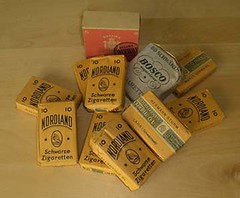
PREV ARTICLE
NEXT ARTICLE
FULL ISSUE
PREV FULL ISSUE
AN ODD AND CURIOUS CURRENCY: CIGARETTE BOXES IN GERMANY
Ursula Kampmann, editor of CoinsWeekly can be counted on for interesting original articles on numismatic topics. This week she linked to an account of her find of a hoard of odd and curious currency - cigarette boxes once used for money in post-war Germany,
-Editor
The situation was quite clear: we were facing a hoard of currency, albeit an unusual one. They were specimens from the post-war era when cigarettes used to be Germany's unofficial means of payment. May be the farmer had traded them for potatoes, eggs and butter. Since he possessed food, he had become such a "rich" man that he was not forced to instantly barter all cigarettes for commodities but hide some boxes in a small hoard for worse times. Some prices in cigarette currency:
Hence, our little hoard represents the equivalent value of 4 ¼ chicken or a quilt cover plus 15 g of ground coffee. The American-blend-cigarettes, especially the trademarks Lucky Strike, Chesterfield and Camel, were the most popular because with their blend they fought hunger most effectively. On the black market, therefore, one got 5 to 40 Reichsmark for an "ami", in contrast to 3 to 12 Reichsmark for a German cigarette - quite a lot of money all the same; after all, in 1946/47 a German worker working in the luxury food industry earned 96 Reichspfennige an hour, officially he had to pay 16 for a German cigarette. An average worker, then, had to work roughly 7 hours to pay his 40 cigarettes per month. The "cigarette hoard" presented here consists solely of cigarettes produced in Germany - even though the "amis" dominated the market, Germany's own production did not come to a halt altogether. It is safe to assume that only very few visitors the Staufen flea market had realized that the small jar contained an extraordinarily rare testimony of our own past that most of us - even though not eye-witnesses on the post-war era – are still familiar with due to the stories we heard from older relatives.
To read the complete article, see:
A relic from Germany's post-war era: a hoard of cigarette boxes
(www.coinsweekly.com/en/A-relic-from-Germanys-post-war-era The Numismatic Bibliomania Society is a non-profit organization promoting numismatic literature. See our web site at coinbooks.org. To submit items for publication in The E-Sylum, write to the Editor at this address: whomren@gmail.com To subscribe go to: https://my.binhost.com/lists/listinfo/esylum All Rights Reserved. NBS Home Page Contact the NBS webmaster 
|

